Selecting the Best Running Shoes for Heavy Runners
Running ranks on the list of activities anyone can enroll in. You don’t need any specific equipment, like a tennis racket for tennis or a ball for soccer. It is a universally accessible form of exercise. However, you still need some things to make the most out of each run. Finding those things is unequally difficult for different people. If you lean on the heavier side, you might find it more complicated to find the shoes that meet your needs. The majority of running shoes are designed with a focus on a different category of runners, but take heart, there are still plenty of options. You just need to learn how to find them. And that’s exactly what we’ll do today.
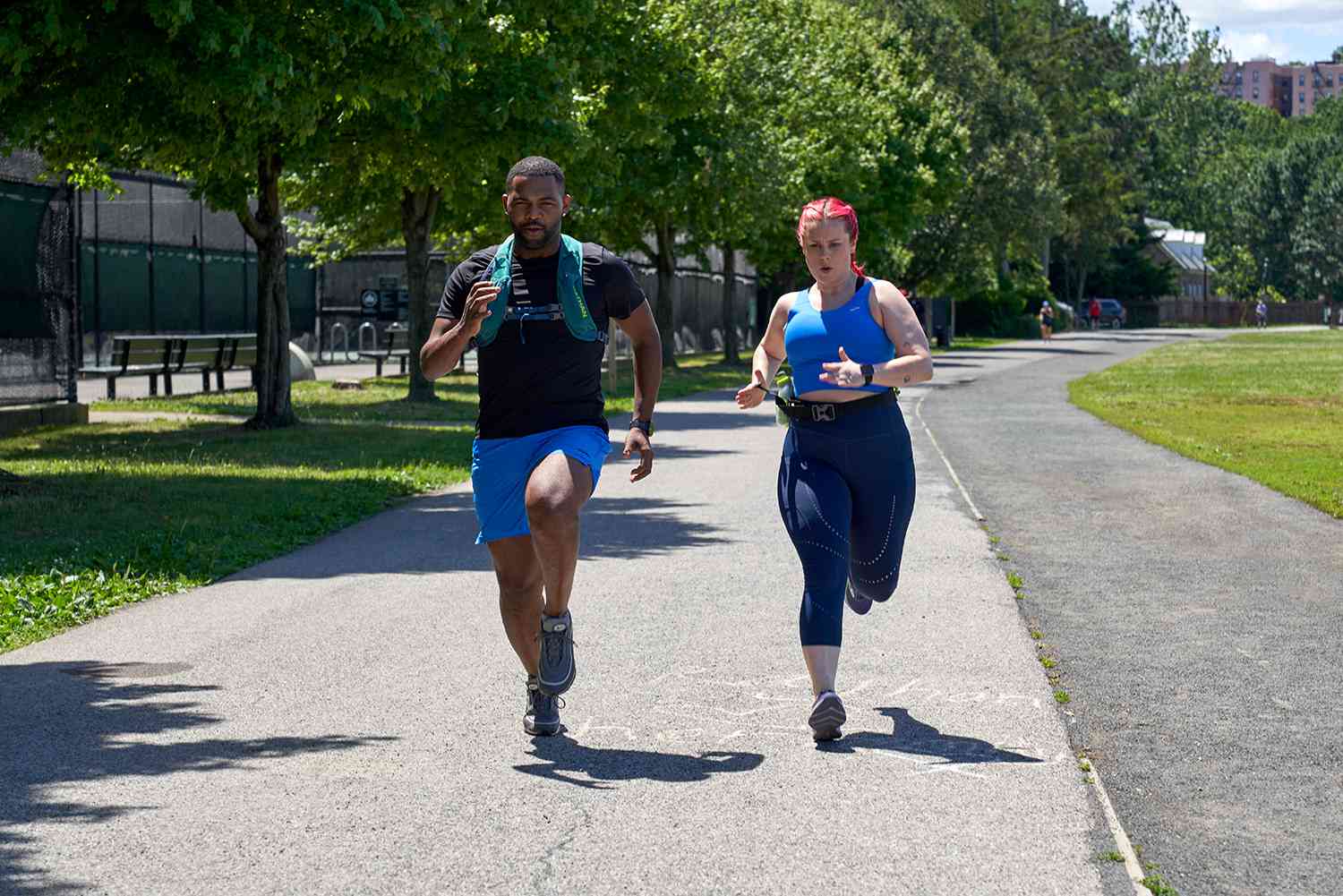
Understanding the Basics
When it comes to choosing and how-to guides, there is always some terminology involved. If you were an experienced runner, well-versed in the matters of running shoe choosing, we bet you wouldn’t need to read a guide to help you choose running shoes. But our target audience is people who are only at the beginning of their running paths, and so our bet is that many terms might make no sense. Since there will be a lot of information regarding all parts of the running shoes, it might be useful to get to know those parts before learning more about them.
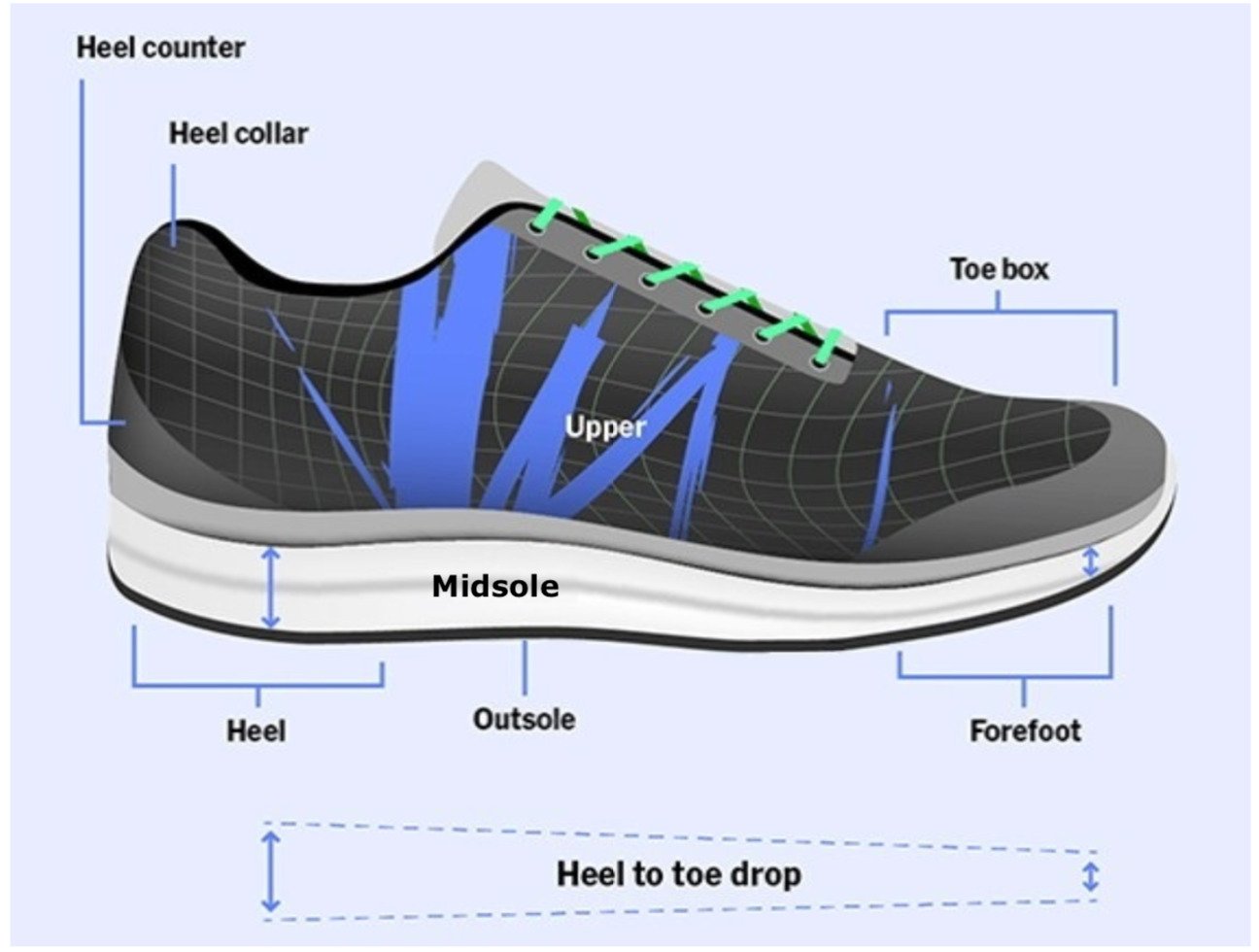
Anatomy of a Running Shoe
A running shoe is a complex assembly designed to address several issues that runners experience during running. Some parts of our feet need protection, some need support and all of them need comfort. Here are the key components you need to know about:
Upper: The upper part of the shoe wraps around the foot's top and is usually made from synthetic materials. It needs to be durable, flexible and breathable. Engineered mesh or knit materials are often used for uppers due to their combination of strength and ventilation.
Toe Box: The front part of the shoe that houses the toes. A properly designed toe box allows enough room for the toes to spread naturally without constriction but is never too spacious. The bottom part of the toe box is called forefoot.
Midsole: The midsole is arguably the most critical part of a running shoe, the one responsible for providing cushioning and shock absorption. It's usually made from foam compounds that compress under pressure but return to their original shape upon release, offering a balance between softness and responsiveness.
Outsole: The outsole contacts the ground and is typically made from rubber or similar material for traction and durability. The pattern and depth of the tread can vary depending on whether the shoe is designed for road running or trail running.
Heel Counter: This component cradles the heel and provides rearfoot stability. A firm heel counter helps control motion for runners who overpronate (roll their feet inward excessively).
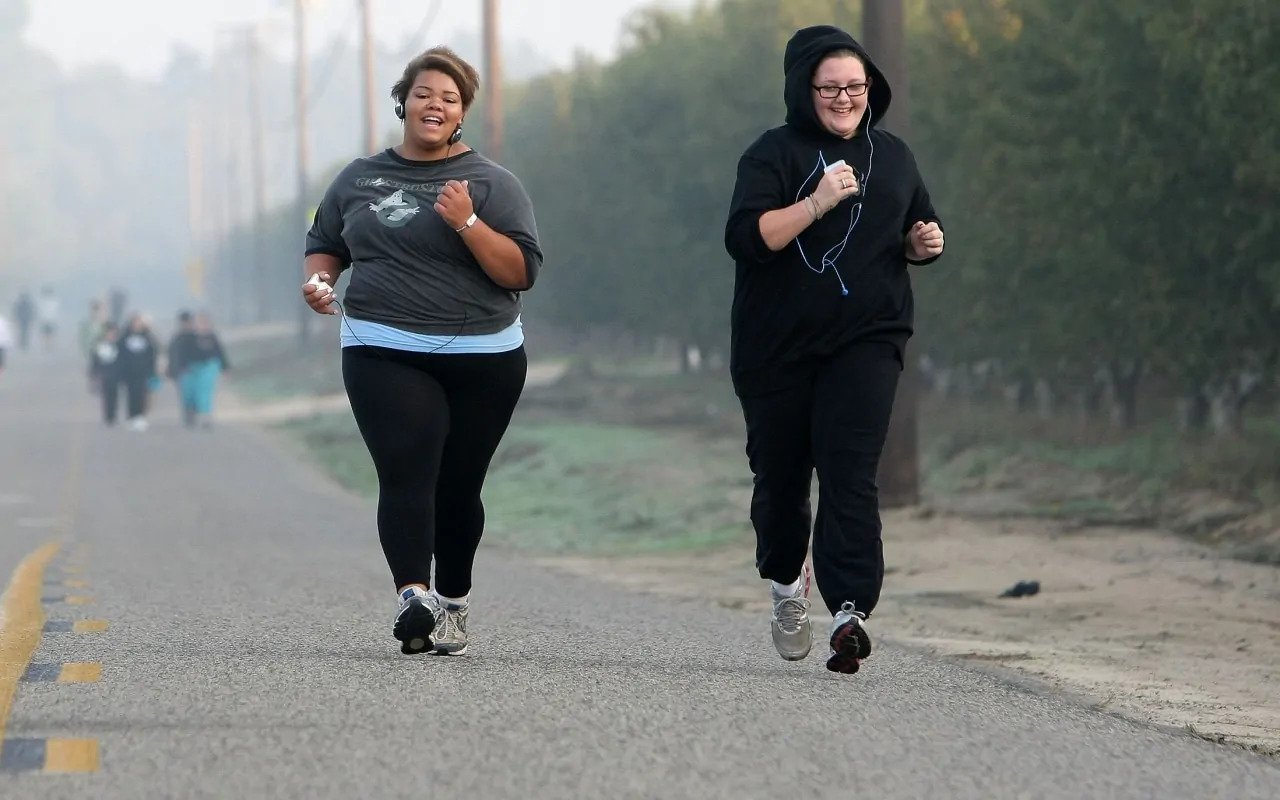
Significance of Proper Fit and Support
A proper fit is paramount for both shoes and apparel. If you never had to suffer through the ordeal of wearing shoes that don’t fit, consider yourself lucky. Unfortunately, blisters and calluses are common companions for some runners. The same goes for injuries - inadequate support or cushioning increases the chances of you hurting yourself. To prevent all of these troubles from finding you, a proper fit is a must. There is no single recipe for it, but there are some staples you can lean on and go from there.
Selecting Running Shoes
As a rule, guides like this unavoidably oversimplify things. After all, we take a big group of people and claim to have a solution that will suit each one of them. And solutions like that never work the way they are advertised - we are all simply too different. There are some very common misconceptions related to choosing running shoes for heavier runners, and most of them trick people with their appealing simplicity. It’s easy to say “Just go for the ones with the softest cushioning” and leave it at that. But such a simple piece of advice is bound to fail. Here are some more simple prescriptions that have all the chances of leaving you worse than you were.
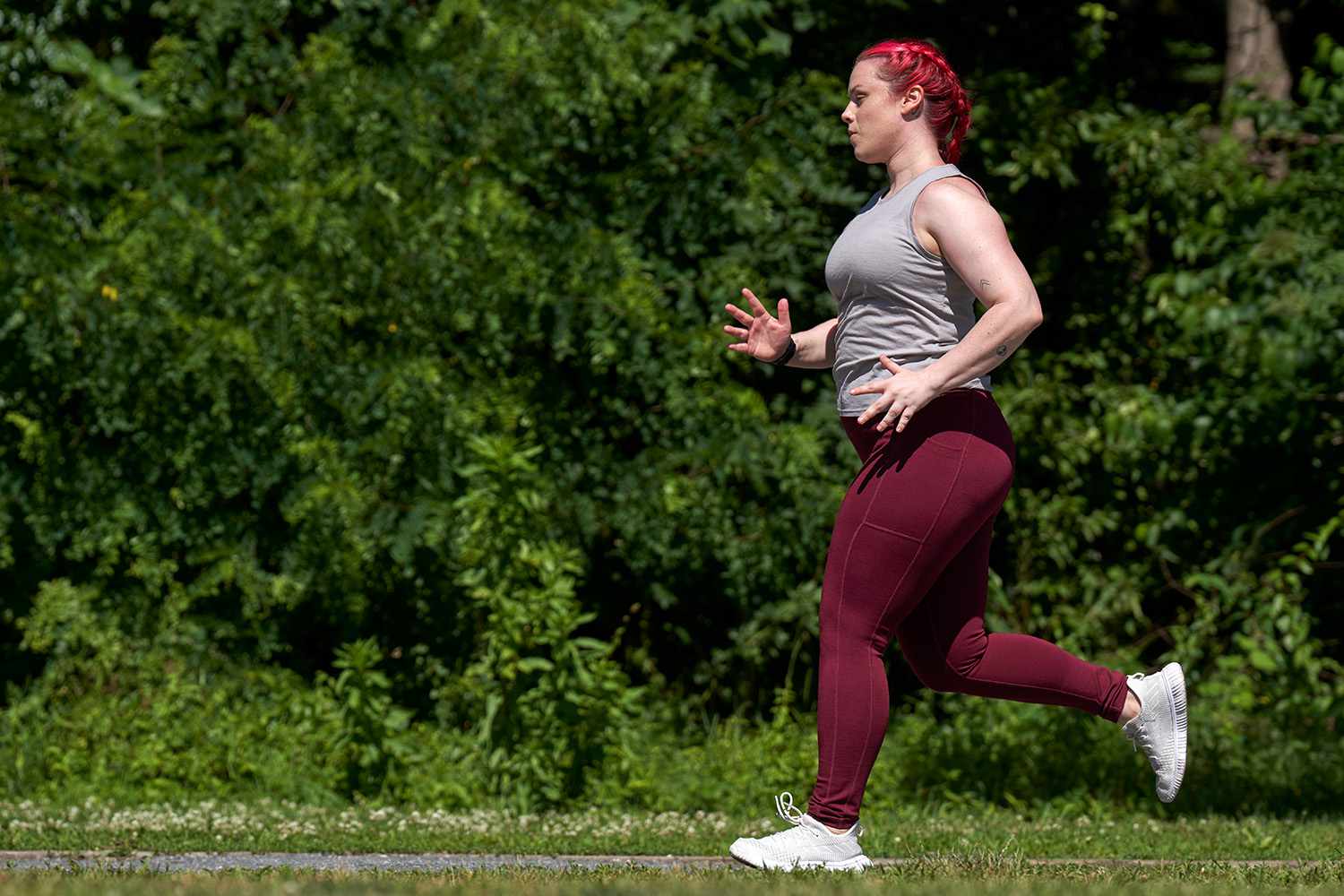
Softer Cushioning Is Always Better - False
It is believed that the softer the shoe, the better it is for shock absorption, which is a crucial feature for heavier runners who exert more force with each step. However, this isn't necessarily true. There is no evidence of a direct correlation between increased softness and better shock absorption.
Even more than that, a cushioned shoe that feels supportive enough for a lighter runner might throw a heavier one off balance. That lack of sufficient support means more workload for the body which it strives to compensate with each further step. That strain increases the risk of injuries and makes running harder and less enjoyable than it should be.
Besides, soft cushioning is much less durable. We are talking about the standard EVA foam compound used in the majority of cushioned running shoes. Midsoles that feature this material tend to wear off pretty quickly, after a few hundred miles. And a heavy runner will see their cushioned shoes wear down even faster. Moreover, excessive softness can cause the shoe to bottom out, making parts of the outsole felt during runs,
Newer foam compounds address the issues of the older version, and there are cushioned running shoes that could still make for a great choice for heavy runners. However, you will need to enquire about the foam material and clarify whether it’s one of the newer models. And the answers might not always be truthful. Unless you are shopping in the Run United physical store. We have all sorts of shoes so there is no point in coaxing you into buying something you won’t find useful.
If cushioning isn’t always the solution, then its opposite, stability, should be a more likely answer, right? Well, not always. Whereas firm running shoes are indeed more suitable for heavier runners, the way this stability is achieved in traditional running shoes isn’t particularly suitable for heavier runners. Hence the next misconception we’ll touch on.
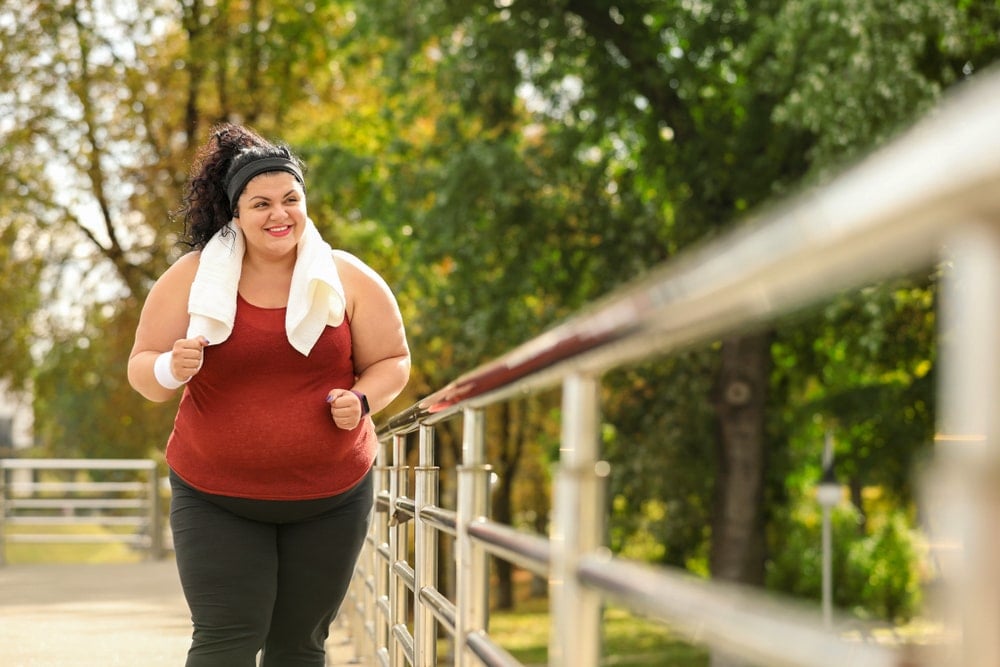
Stability Shoes Are Always Better - False
Stability shoes, designed with a firmer inner midsole to prevent inwards rolling of the foot usually come with a softer outer sidewall. Such a construction might cause the body weight to lean laterally following the path of least resistance. And since we are talking about heavy runners, there will be more weight to follow that path. This can bring about discomfort rather than the stability you counted on. Not all stability shoes have this drawback, but as you can see, going for just any stability shoe won’t work.
So, what do we have at the end? Neither of the shoe types is an absolute favorite. And, since those are two extremes of the same spectrum, there is only one place for us to go - in the middle.
Seek Cushioned Yet Supportive Shoes
It's crucial to find shoes that offer a balance between cushioning and support. Cushioning, though not a panacea, is necessary to protect the feet from impact forces. At the same time, the shoe needs to be supportive enough to handle a heavier weight without compromising stability.
We understand that this piece of advice doesn’t necessarily make things easier. We could have just said “The softer the cushioning, the better the shock absorption” and leave you at that. But you will need to do some browsing before settling for that one pair you’d acquire.
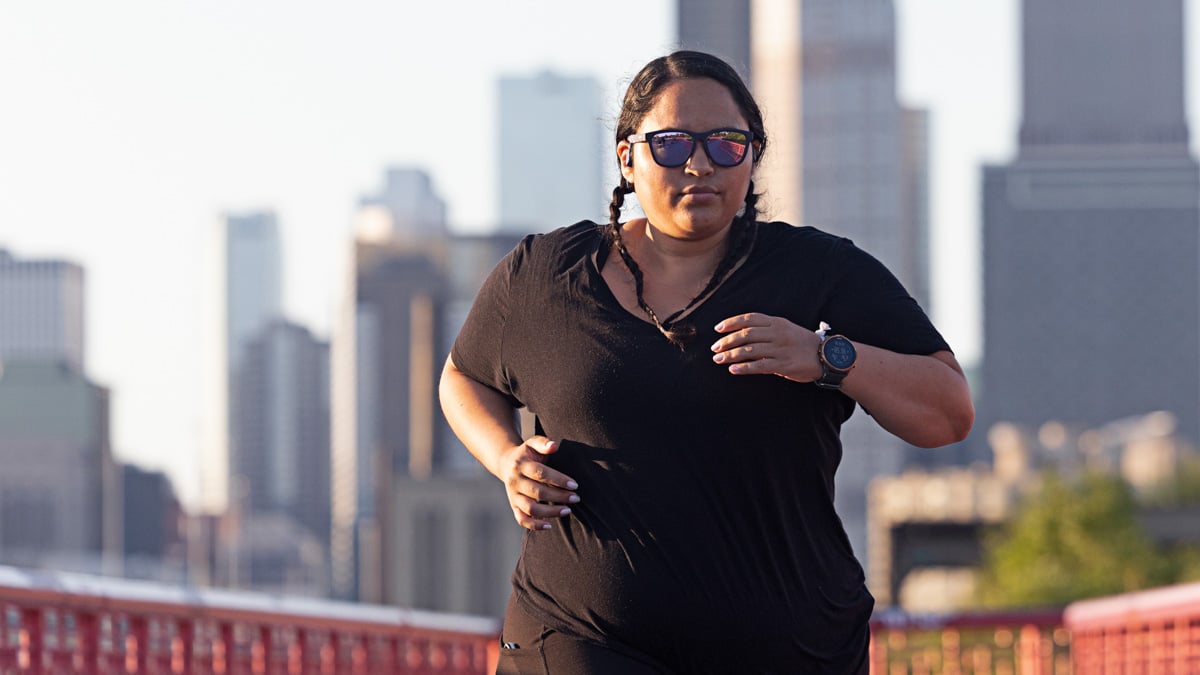
Here are a few more pieces of advice you can keep in mind while looking for that one pair.
Consider the Shoe's Width and Volume: It might seem very apparent, but the shoe needs to accommodate your foot's width and volume. Heavier runners often have broader and more voluminous feet, so the shoes need to have ample space without constricting movement. North American brands have no problem offering wide-size options, but the same can’t be said about many European brands, which tend to run narrow.
Prioritize Stability Features Over Softness: If we are leaning somewhere on the “softness-stability” spectrum, it is in the direction of stability. But the midsole isn’t the only feature responsible for stability. A wide platform, guide rails, a stiff (non-flexible) heel counter and strategically placed firm cushions can offer both the stability and support needed without the drawbacks of being overly soft.
Comfort Is Key: With all this race for functionality and performance, it’s easy to forget that the shoe must be, first and foremost, comfortable. No amount of advanced technology, marketing or convincing words can substitute for how the shoe feels on your feet. Comfortable shoes encourage better performance by simply feeling good on your feet.
Professional Gait Analysis: Even though the weight might be a uniting factor, the gait is 100% a differentiating one. They are also the reason why it’s so hard to give advice that a lot of people could apply. If you want to learn more about your gait, visit a specialty running store for professional gait analysis - this thing is impossible to do on your own. Run United just happens to have both equipment and specialists who can give you personalized shoe recommendations based on your running form, weight, and specific needs. If you live in or near North Richland Hills, drop by, we are always happy to help.
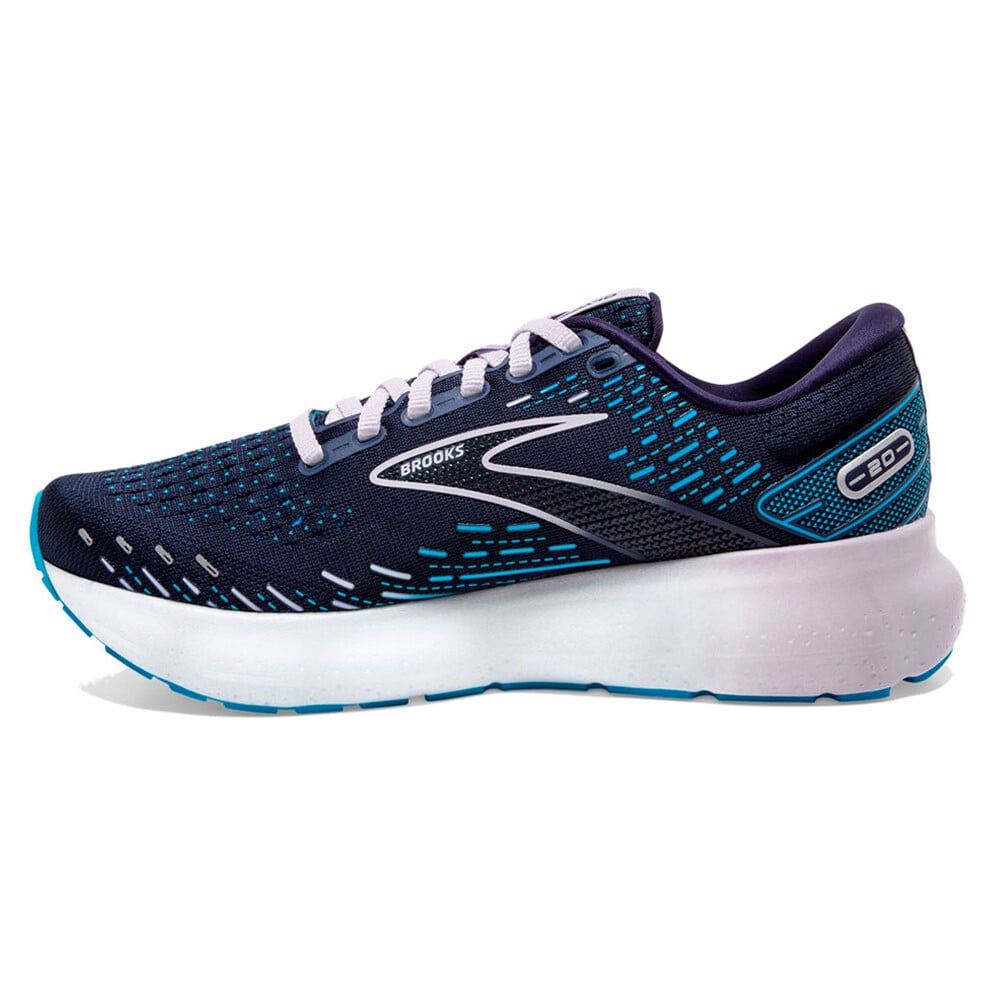
Brooks Glycerin 20
If you seek a blend of support and plush cushioning, then Brookshas something that can meet that need. Their latest iteration of the Glycerin series introduces several key features that make it particularly suitable for those carrying extra weight, emphasizing a balance between a medium-soft ride and sufficient cushioning.
The cushioning, by the way, is next level. Brooks infused it with nitrogen (DNA LOFT v3, they call it), making it very soft but in a way that still feels responsive when you're hitting the pavement. It means less jarring on your joints and a smoother ride from start to finish, which is helpful to anyone, really.
The shoe's medium-soft ride strikes an ideal balance for those who prefer a running shoe that borders on firm yet retains a generous layer of step-in softness. It's not too soft where you feel like you're sinking, but there's enough give to make your runs comfy. Plus, there's a removable insole that adds an extra layer of cushiness. If you've got special insoles or just like tweaking your shoe's feel, this is a nice touch.
Breathability is another big win. The top part of the shoe lets your feet breathe easily, so even on those longer runs, you're not going to feel like your feet are soaking in your own sweat. That’s an overly nice feature, everyone can enjoy it.
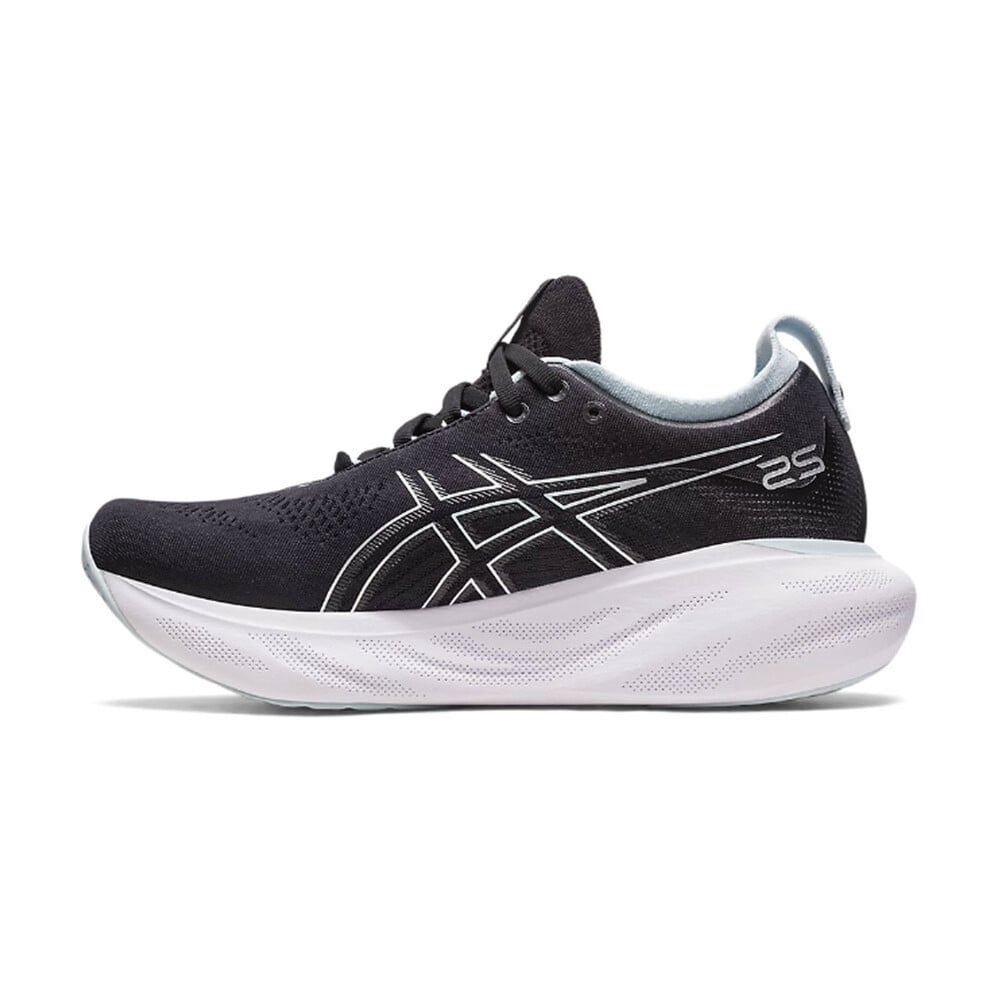
ASICS Gel-Nimbus 25
The ASICS Gel-Nimbus 25 is another standout for higher-weight runners and basically anyone in need of extra support without sacrificing comfort. This model has clearly been designed with an emphasis on creating a soft, cloud-like experience for runners, incorporating several innovative features that contribute to its plush feel and stability.
One of the most notable upgrades in the Gel-Nimbus 25 is the integration of full-length FF BLAST PLUS ECO technology combined with rearfoot PureGEL cushioning. The only thing you need to know about this combination of names is that it provides a ride that's as soft as it is responsive, ensuring that each step is both comfortable and efficient. The technology is very effective at absorbing impact. This feature alone makes the Gel-Nimbus 25 a top choice for those seeking a cushioned run without compromising on performance.
Adding to the shoe's appeal is the new knit upper, which is both stretchy and supportive. As a result, you get a snug fit that adapts to your foot's movements, providing a secure feel without any tightness or restriction. The breathability of the material also means that your feet stay cool and dry.
Despite its cushioning, the Gel-Nimbus 25 does not feel overly soft or unstable underfoot. This is a significant consideration for higher-weight runners who require a shoe that offers solid support. The neutral rockered ride of the Gel-Nimbus 25 delivers just that, providing a stable base for every stride.
Saucony Echelon 9
The Saucony Echelon 9 has a lot of reasons to be featured on this list. This latest iteration has been meticulously engineered to eliminate the drawbacks of the previous models while preserving all the merits that brought it its current reputation.
One of the standout features of the Echelon 9 Wide is its roomy fit. This provides a comfortable environment for your feet, allowing them to expand naturally with each stride. The spacious interior accommodates wider feet effortlessly, and since it is a Wide model, rest assured your feet will feel right at home in these shoes.
Stability is another key aspect where the Echelon 9 Wide shines. Saucony uses the cushioned yet supportive Pwrrun midsole foam, which grants the shoes high levels of inherent stability. The combination of a supportive frame and cushioning that's firm yet forgiving results in a very satisfying running experience. With these shoes, you will have the confidence to push yourself further without worrying about overpronation or underpronation issues.
The shoe is also very lightweight, saving about 2 ounces when compared to its predecessor, Echelon 8. It features a custom PU insole that can be easily changed for something else, so custom insole fans can rejoice. Both the heel collar and tongue have been generously padded, the upper is very soft as well, so consider the Echelon 9 a portable cloud with a sturdy middle that will let you waft through the air while not feeling like you are sinking in it.
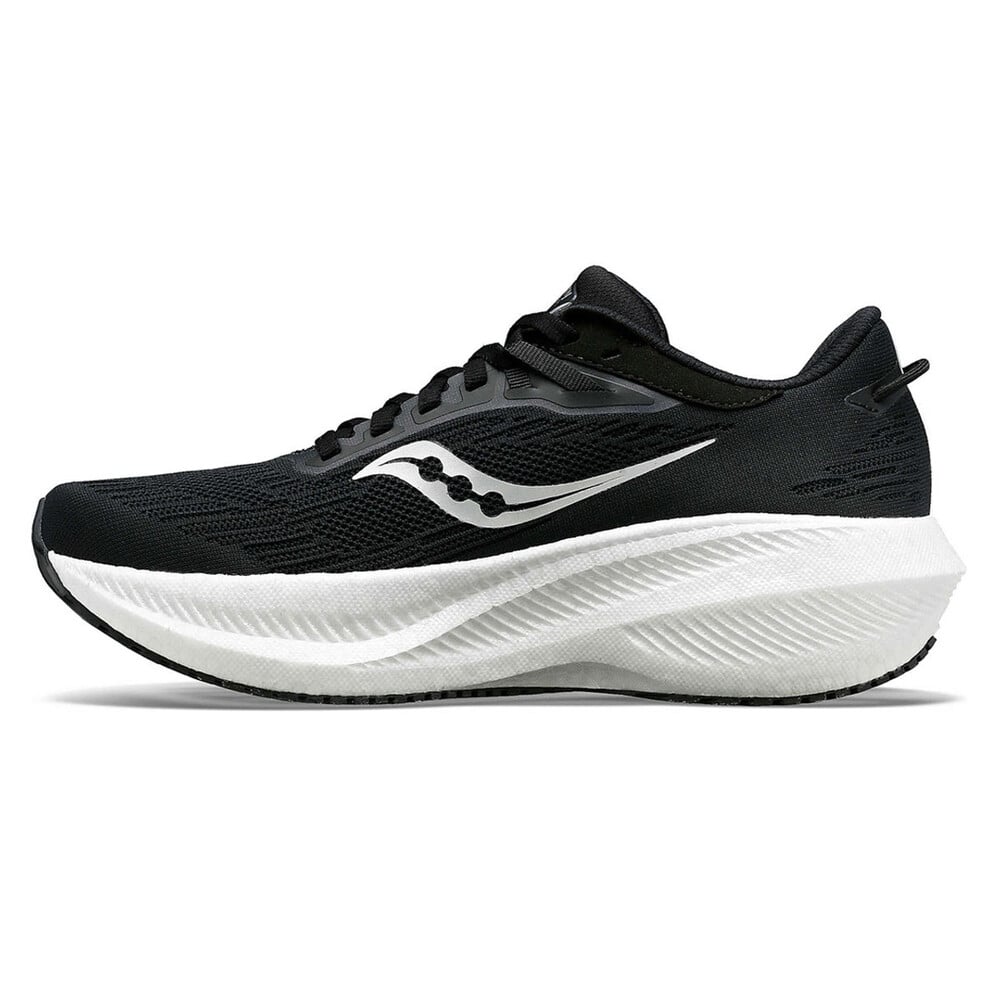
Saucony Triumph 21
The Triumph 21 Wide is another remarkable shoe, bearing the mark of Saucony quality. One of the most commendable attributes of the Triumph 21 Wide is its spacious upper. Measuring a broad 102.1 mm at its widest point, the shoe offers ample room, making it an ideal choice for runners with wide feet or those who experience foot swelling during long runs.
Furthermore, the Triumph 21 Wide doesn't compromise on stability. The Triumph 21 Wide strikes a perfect balance by offering a stable ride that supports the foot through each phase of the gait cycle. The shoe rolls easily from heel to toe, in part thanks to the springy foam under the heel.
Cushioning is another area where the Triumph 21 Wide excels. Despite its lighter relative weight, this shoe boasts a high amount of cushioning, delivering exceptional energy return and shock absorption.
FAQs
What makes running shoes suitable for heavy runners?
Running shoes for heavy runners need to offer a balance between cushioning and support to accommodate higher impact forces, ensure stability, and prevent injuries. They should have durable midsoles, supportive features, and be designed to handle the extra weight without compromising comfort.
Can soft cushioning in running shoes be a disadvantage for heavy runners?
Yes, while soft cushioning might seem beneficial for shock absorption, it can actually lead to instability and increased risk of injury for heavier runners. Shoes that are too soft may lack the necessary support, leading to overpronation and discomfort.
What are some key features to look for in running shoes for heavy runners?
Look for shoes with ample width and volume to accommodate broader feet, prioritize stability features over extreme softness, and ensure the shoe offers a comfortable fit. Additionally, consider shoes with a wide platform, guide rails, a stiff heel counter, and strategically placed firm cushions for balanced support and cushioning.
Why is professional gait analysis recommended for heavy runners looking for the right running shoes?
Professional gait analysis can provide personalized recommendations based on an individual's unique running form, weight, and specific needs. Since every runner's gait is different, this analysis helps identify the most suitable shoes that offer the right balance of cushioning, support, and stability.
Are there specific running shoe models recommended for heavy runners?
Yes, some of the recommended models include the Brooks Glycerin 20, ASICS Gel-Nimbus 25, Saucony Echelon 9, and Triumph 21. These shoes are praised for their blend of support, cushioning, and durability, making them suitable choices for heavier runners in need of stable and comfortable footwear.
EXPLORE POPULAR ARTICLES
-
Running Glossary: Terms & Slang Every Runner Must Know
Aug 26th 2024When you dive into the world of running, you'll quickly notice that it has its own unique vocabulary
-
Best Leather Walking & Running Shoes and Sneakers
Jul 29th 2024Are Leather Running Shoes Still a Thing? You might not have realized it, but leather runnin
-
How to Break In Running Shoes [Expert Guide]
Jun 20th 2024It's rare when a couple of short walks around the block is enough for a runner to break in a new pai





![How to Break In Running Shoes [Expert Guide] How to Break In Running Shoes [Expert Guide]](https://cdn11.bigcommerce.com/s-eeul26hjka/images/stencil/160w/uploaded_images/how-to-break-in-running-shoes.jpg?t=1718884434)